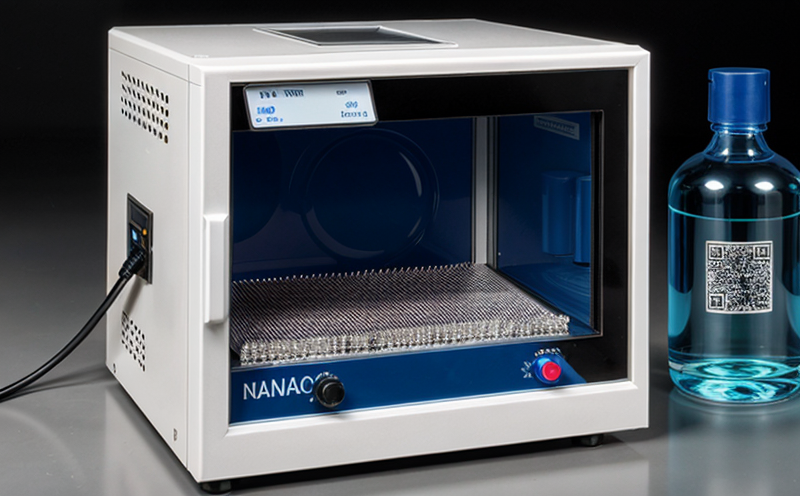JIS K0050 Nanomaterial Residue Testing by Chromatography
The JIS K0050 standard specifies a method for quantifying nanomaterial residues in various products using chromatographic techniques. This service is critical for ensuring compliance with international standards and regulatory requirements, particularly relevant to sectors such as electronics, healthcare, cosmetics, and environmental science.
Nanomaterials are increasingly incorporated into everyday products due to their unique properties that enhance performance. However, the presence of nanomaterial residues can pose risks if not properly managed or monitored. JIS K0050 provides a standardized approach for testing these residues, ensuring consistency across laboratories and facilitating reliable results.
The analytical process involves several key steps: sample preparation, derivatization (if necessary), injection into the chromatographic system, separation of components, detection, and quantification. Chromatography is chosen for its ability to separate complex mixtures with high precision and sensitivity, making it ideal for detecting nanomaterial residues at very low concentrations.
For accurate testing, specimens must be prepared carefully to avoid contamination or degradation that could affect the results. This includes thorough cleaning of equipment, controlled environments during sample handling, and precise weighing and dissolution techniques. The choice of chromatographic column and mobile phase is critical as it influences both separation efficiency and detection limits.
The JIS K0050 protocol also specifies detailed operating conditions for the chromatography, including temperature settings, flow rates, and detector types. These parameters are crucial in achieving optimal performance and ensuring that the instrument can reliably detect nanomaterial residues even at trace levels.
Once the analysis is complete, results are reported according to JIS K0050 specifications. Reports typically include details on the type of nanomaterial detected, its concentration, and any relevant reference standards or guidelines used in the process. This information is invaluable for quality managers, compliance officers, R&D engineers, and procurement teams who need assurance that products meet necessary safety and regulatory requirements.
The method's precision and accuracy make it particularly suitable for industries where product integrity and safety are paramount. By adhering to JIS K0050 standards, manufacturers can demonstrate commitment to quality control and consumer protection, thereby enhancing their reputation in competitive markets.
In summary, the JIS K0050 Nanomaterial Residue Testing by Chromatography service offers a robust framework for detecting nanomaterial residues. It supports industries in maintaining product integrity and ensuring compliance with international standards, thus contributing to safer and more reliable products.
Benefits
The JIS K0050 Nanomaterial Residue Testing by Chromatography service provides numerous benefits that are essential for maintaining product quality and ensuring compliance with international standards. Here's how this service can impact various aspects of your operations:
- Enhanced Product Safety: By identifying nanomaterial residues, manufacturers can take necessary steps to mitigate risks associated with these materials.
- Informed Decision-Making: Accurate testing results enable informed decisions regarding product formulations and manufacturing processes.
- Compliance Assurance: Ensures that products meet strict regulatory requirements set by international standards like JIS K0050.
- Market Reputation: Demonstrates a commitment to quality, which can enhance consumer trust and brand reputation.
- Risk Management: Early detection of potential issues helps in implementing corrective actions promptly.
- Cost Efficiency: By preventing non-compliance issues, the service contributes to long-term cost savings by avoiding penalties or recalls.
In conclusion, adopting JIS K0050 Nanomaterial Residue Testing ensures that your products remain safe, compliant, and competitive in today's global market.
Competitive Advantage and Market Impact
The implementation of the JIS K0050 Nanomaterial Residue Testing by Chromatography service can significantly enhance a company's competitive edge and market impact. Here’s how it contributes to these goals:
- Quality Leadership: By adhering strictly to international standards, companies position themselves as leaders in quality assurance.
- Innovation Facilitation: The ability to test nanomaterial residues accurately fosters innovation by allowing for continuous improvement and development of new products.
- Customer Confidence: Demonstrating compliance with JIS K0050 builds trust among customers, leading to increased sales and market share.
- Regulatory Compliance: Ensuring adherence to all relevant standards reduces the risk of legal issues and penalties.
- Supply Chain Reliability: By maintaining consistent quality throughout the supply chain, companies enhance reliability and trust with their partners.
In an increasingly competitive environment, these advantages can be pivotal in differentiating your products and services. Embracing such a service underscores your company’s commitment to excellence and sets it apart from competitors.
Use Cases and Application Examples
| Industry Sector | Product Type | Testing Objective | Key Findings |
|---|---|---|---|
| Electronics | Microprocessors | Detection of nanoscale contaminants | Identification of specific nanomaterial residues that could affect processor performance. |
| Healthcare | Clinical Diagnostics Devices | Evaluation of biocompatibility | Assessment of nanoparticle concentrations to ensure compatibility with biological systems. |
| Cosmetics | Sunscreen Lotions | Ensuring safety and efficacy | Determination of nanoparticle content for regulatory compliance. |
| Environmental Science | Water Purification Systems | Evaluation of filtration efficiency | Measurement of nanomaterials that might pass through filters. |
| Industry Sector | Product Type | Testing Objective | Key Findings |
|---|---|---|---|
| Construction Materials | Solar Panels | Evaluation of adhesive properties | Detection of nanomaterial residues in adhesives for enhanced performance. |
| Tire Manufacturing | Automotive Tires | Ensuring durability and safety | Identification of nano-sized particles that might affect tire longevity and safety. |
| Consumer Goods | Fabric Softeners | Evaluating nanoparticle content | Determination of nanoparticle levels to ensure safe use in fabric softener products. |
| Biochemical Research | Laboratory Equipment | Preventing contamination | Identification and quantification of nanomaterial residues that could compromise research accuracy. |
The diverse applications highlighted above illustrate the broad utility of JIS K0050 Nanomaterial Residue Testing by Chromatography across various industries. This comprehensive testing ensures that products are safe, effective, and compliant with international standards.





